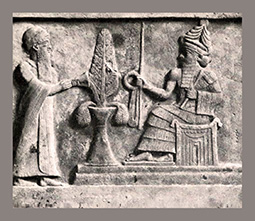Author: E. Pappalardo
Download article as .pdf: From the things to the images. The representation of the tree in ancient times
 In this article it will be attempted to carry a cross-cut analysis on the sacred tree symbol in the ancient world. In particular, Near East and Aegean will be investigated and compared, trying to provide more than an answer to the possible meaning that the sacred tree had, involving archaeological attestations, literary sources and images. The research starts from the Assyrian orthostats where sacred tree is associated with the king or sacred creatures, and ends in Iron Age Crete where, already in the second half of IX cent., the tree is variously represented on bronze artefacts and pottery. For each investigated area, it will be tried to associate evidence provided by images with the archaeological record where hypothetical association asherah/bamah can be plausibly recognized.
In this article it will be attempted to carry a cross-cut analysis on the sacred tree symbol in the ancient world. In particular, Near East and Aegean will be investigated and compared, trying to provide more than an answer to the possible meaning that the sacred tree had, involving archaeological attestations, literary sources and images. The research starts from the Assyrian orthostats where sacred tree is associated with the king or sacred creatures, and ends in Iron Age Crete where, already in the second half of IX cent., the tree is variously represented on bronze artefacts and pottery. For each investigated area, it will be tried to associate evidence provided by images with the archaeological record where hypothetical association asherah/bamah can be plausibly recognized.
